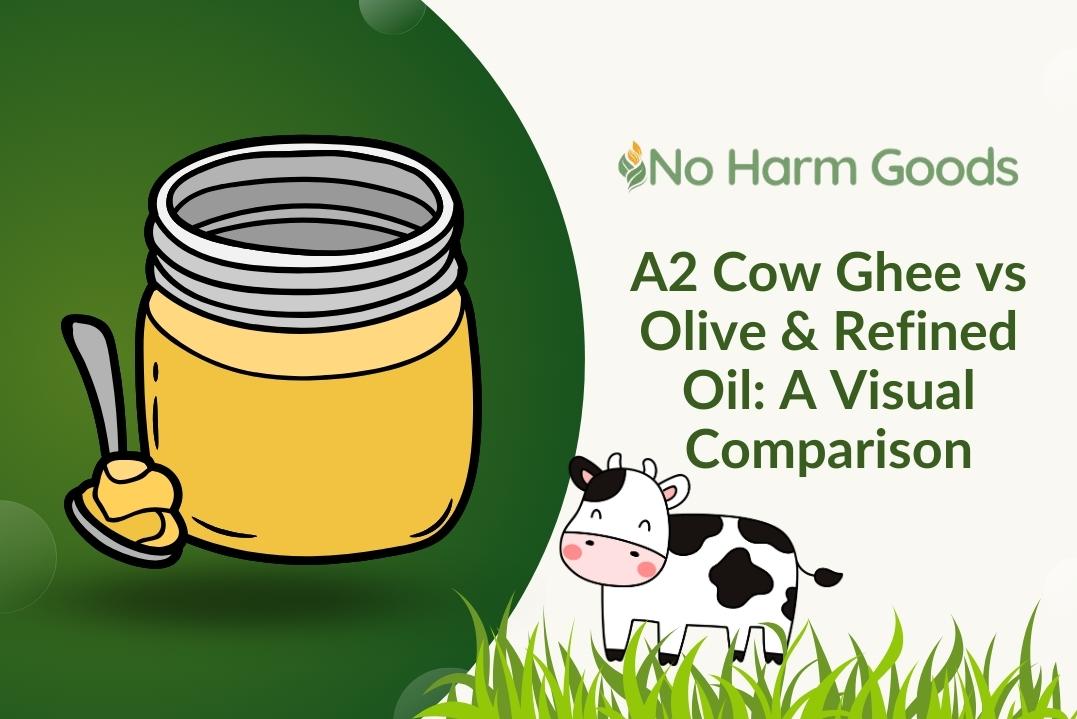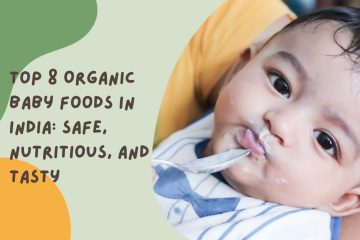In the realm of cooking oils and fats, there exists a longstanding debate between proponents of A2 cow ghee and those of olive and refined oils. While both types of oil have their own unique properties and benefits, there are also many misconceptions surrounding their use. In this article, we will aim to dispel these myths and provide a balanced perspective on the nutritional value and health implications of these popular cooking mediums.
What is Ghee?
In addition to some Middle Eastern and African culinary rituals, Indian and South Asian cuisines frequently use ghee, a type of clarified butter. Unsalted butter is simmered until the water content is gone and the milk solids separate from the pure butterfat to generate it. The clear, golden-yellow liquid known as ghee is then left behind after the milk solids are successfully removed.
How to Prepare Ghee
1. Ingredients:
- Unsalted butter (as much as you’d like to make ghee)
2. Equipment:
- A deep, thick-bottomed pot or a saucepan with a heavy bottom
- Wooden fork or spoon
- Cheesecloth or a fine-mesh strainer
- A glass or metal container made of clean, dry materials for keeping the ghee.
3. Instructions:
- Cut the Butter: Start by chopping or cubing the unsalted butter. It promotes more even melting.
- Melt the butter: Put it in a pot or saucepan with a thick bottom. The butter should be slowly melted through low to medium heat. For the water content to evaporate and the milk solids to separate without burning, the butter must be gently melted.
- Clarify and Simmer: Once the butter has melted completely, turn down the heat to a simmer. The butter will go through various stages as it simmers:
- Stage of Foaming: At first, the butter will begin to foam on the surface. The evaporating water is the cause of this.
- Stage of Separation: As the butter simmers longer, it will separate into three distinct layers: milk solids on the bottom, clarified butter (ghee) in the middle, and foam on top.
- Examine the Foam: The foam that develops on the surface of the butter should be gently scraped off using a wooden spoon or spatula. This foam is made of water and small amounts of milk solids.
- Watch for Colour Change: The butter will gradually turn from a pale yellow to a rich golden or amber shade as it simmers. This change in color indicates that the milk solids at the bottom have slightly browned, giving the mixture a nutty flavour.
- Remove from Heat: After the butter turns the desired shade of golden brown without turning burnt, turn off the heat. Avoid overcooking, as it can change the flavor.
- Strain the Ghee: Pour the ghee through a fine-mesh strainer or a piece of cheesecloth into a dry, clean glass or metal container to separate the milk solids from the pure ghee. Any remaining milk solids will be caught in the filter, leaving you with clear ghee.
- Cool and Store: Allow the ghee to cool to room temperature before storing. Though it slightly solidifies, it will still be spreadable. Put a lid on the container and store it somewhere cool and dark that is out of direct sunlight. Ghee does not need refrigeration and has a long shelf life.
Ghee’s nutritional value compared to Olive and Refined oil
| Nutritional Parameter | Ghee | Olive Oil (Extra Virgin) | Refined Vegetable or Seed Oil |
| Calories (per tablespoon) | Approximately 120 | Approximately 120 | Approximately 120 |
| Fat Composition | Primarily Saturated Fat (around 50-65% of total fat content) | Primarily Monounsaturated Fat (mainly oleic acid) | Mix of Saturated, Monounsaturated, and Polyunsaturated Fats (varies by source) |
| Vitamins | Contains fat-soluble vitamins, including vitamin A, D, E, and K, in varying amounts depending on the source and production method | Contains vitamin E and small amounts of vitamin K | Tends to have minimal vitamin content due to refining process |
| Lactose and Casein | Virtually free of lactose and casein due to the clarification process, making it suitable for some lactose-intolerant individuals | Largely lactose-free L | Largely lactose-free L |
| Antioxidants | Contains antioxidants like conjugated linoleic acid (CLA) and butyric acid, which may have health benefits | Rich in antioxidants, particularly polyphenols, which have anti-inflammatory properties. | Generally have fewer antioxidants than extra virgin olive oil |
| Omega-3 Fatty Acids | Not a significant source of omega-3 fatty acids | Contains a small amount of omega-3 fatty acids | Some oils (e.g., flaxseed, canola) contain higher levels of omega-3 fatty acids |
Shocking Truth Revealed: The Myth-Busting Reality Behind Your Ghee!
Prepare to have your beliefs shaken and myths shattered as we unveil the astonishing truth about ghee. Are you ready to discover the surprising secrets behind this golden elixir? Let’s embark on a journey of myth-busting revelations!
Here’s a comparison of A2 Pure Ghee, made through the Vedic Bilona method from 100% Desi Gir Cow milk, and other popular brands of Desi Ghee:
| Criteria | A2 Pure Ghee (Vedic Bilona) | Most Popular Brands |
| Milk Source | 100% Desi Gir Cow milk | Various Cow Breeds |
| Production Method | Vedic Bilona Process | Modern Techniques |
| Nutritional Value | Rich in A2 proteins and nutrients | May vary depending on source |
| Purity and Authenticity | High purity, follows ancient traditions | May use hybrid cow milk |
| Flavor and Aroma | Rich, authentic, and aromatic | May lack traditional flavor |
| Nutrient Retention | Maximum retention of natural nutrients | Nutrient loss possible |
| Health Benefits | A2 milk may have digestive benefits | May not offer the same |
| Environment-Friendly Practices | Sustainable and eco-friendly methods | Maybe premium-priced due to the authenticity |
| Traditional vs. Commercial | May be premium-priced due to the authenticity | May prioritize commercial interests |
| Transparency in Sourcing | Clear sourcing from Desi Gir Cows | May lack transparency |
| Price | Maybe premium-priced due to the authenticity | Competitive pricing |
The A2 Ghee: Gold Standard as per our Research
Indulge in the pure essence of health and tradition with our top A2 Pure Ghee recommendations. Discover the rich, authentic flavors that only A2 Ghee can provide, and elevate your culinary experience to new heights.
1- Farm Naturelle-A2 Desi Ghee Cow from Grass Fed Sahiwal Cows | Vedic Bilona method
Discover the potential benefits of pure A2 Cow ghee, cherished in India for:
- Brain Health: A belief in enhanced cognitive function and memory.
- Cardio Support: Thought to strengthen the heart.
- Stronger Bones: It’s considered to boost bone density.
- Radiant Skin: May contribute to a healthy glow and dark circle management.
- Hair Vitality: Believed to strengthen hair.
- Digestive Aid: Linked to digestion and weight management.
Farm Naturelle-A2 Cow ghee is produced using the traditional Vedic Bilona method, ensuring authenticity and quality. From milk to granulated yellow cow ghee, experience the best of tradition and well-being.

2- Golden Bliss – 100% Pure Desi Sahiwal Cow Ghee
Experience the goodness of Golden Bliss Desi Sahiwal Cow Ghee – available on Amazon for a healthier lifestyle!

3- DIVYA KAMDHENU A2 Pure Ghee – 100% Desi Gir Cow
Indulge in the purity and tradition of DIVYA KAMDHENU A2 Pure Ghee – a versatile addition to your diet. Available on Amazon for a delightful culinary experience!

3- SHREERADHEY Gir Cow Ghee – A2 Bilona Traditional Method – 1 L Tin
Experience SHREERADHEY’s A2 Gir Cow Ghee – on Amazon now!

Do Not Miss: Best Toner for Oily Skin – TOP 10 ORGANIC TONERS FOR ACNE PRONE SKIN
4- Vedic Ghee Premium A2 Gir Cow Ghee – 1L
Discover the purity and flavor of Vedic Ghee Premium A2 Gir Cow Ghee on Amazon!

5- GirOrganic A2 Pure Ghee – 500 ml Glass Bottle
Experience the goodness of GirOrganic A2 Pure Ghee – available now on Amazon!

6- Two Brothers Organic Farms A2 Ghee – 500 ml
Discover the excellence of Two Brothers Organic Farms A2 Ghee on Amazon!

7- Yugmantra Organic Foods A2 Milk Sahiwal Cow’s Grass-Fed Desi Ghee – 1 Litre
Discover the excellence of Two Brothers Organic Farms A2 Ghee on Amazon!

Ways to Incorporate Ghee into Your Diet
Ghee should be consumed in moderation and carefully included in your diet. Here are some suggestions for sensible ghee usage:
- Moderation: Ghee should only be consumed in moderation because it contains calories. Generally, it is advised to keep consumption to 1-2 tablespoons per day, depending on your dietary requirements and total calorie intake.
- Dietary Balance: Ghee is best consumed as part of a nutritionally sound diet. You can use it as a cooking fat or to add flavour to hot dishes like rice or vegetables.
- Cooking Method: Ghee is suitable for high-temperature cooking techniques like sautéing and frying due to its high smoke point. When heated, it retains its nutritional qualities. It doesn’t degrade easily.
- Nutrient Absorption: Consuming foods high in the fat-soluble vitamins A, D, E, and K, along with ghee, can improve the absorption of these nutrients.
- Cultural Dishes: Enjoy ghee in classic Indian curries and desserts, as well as other foods from other cultures. It enhances the flavors of these foods.
- Health Considerations: Before using ghee in your diet, especially if you have concerns about your heart health or cholesterol, speak with a healthcare provider or trained dietitian if you have any specific health issues.
Ghee’s Advantages for External Use
The inherent qualities of ghee can be used for exterior purposes. Here are some advantages of ghee on the outside:
- Moisturiser for Skin
- Lip Balm
- Hair Conditioner
- Cuticle Softener
- Wound Healing
- Makeup Remover
How to avoid eating ghee
- Excessive Ghee sweets- Although ghee is a delectable and necessary component of many traditional desserts, eating an excessive amount of ghee-based treats may have some unfavorable effects like Weight gain, High Cholesterol, Elevated Blood Sugar, etc.
- Ghee+Curd- Taking too much ghee, curd, or a combination of the two can cause certain problems such as Digestive Discomfort, Lactose Sensitivity, Caloric Intake, etc.
- Ghee+Honey- Curd and honey, when combined, will turn poisonous.




